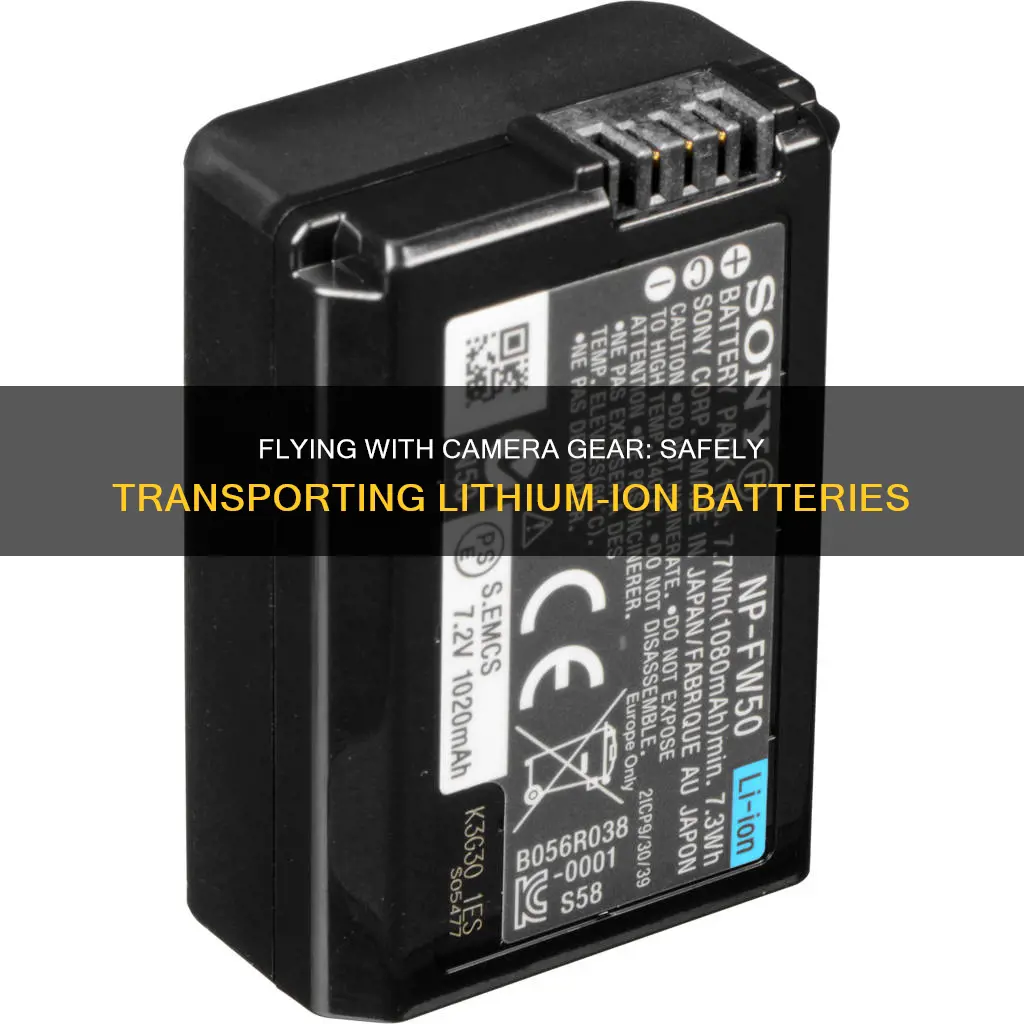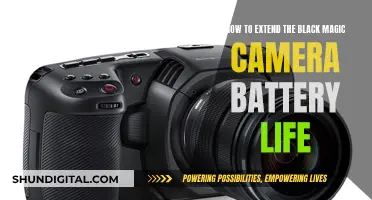
Lithium-ion batteries are commonly found in smartphones, laptops, tablets, and camera equipment. Due to their potential for rapid combustion, aviation authorities such as the FAA and EASA have specific rules in place for travelling with these batteries on planes. While lithium-ion batteries installed inside cameras are generally considered safe, there are important guidelines to follow when travelling with spare batteries to ensure safety.
| Characteristics | Values |
|---|---|
| Type of battery | Lithium-ion |
| Devices that use lithium-ion batteries | Smartphones, laptops, tablets, camera equipment |
| Where to keep lithium-ion batteries | Carry-on baggage |
| How to pack lithium-ion batteries | In original packaging or with taped-over charging interface/connectors |
| Number of lithium-ion batteries allowed | No limit for batteries under 100Wh; 2 batteries between 101-150Wh |
| Weight limit | Depends on airline |
| Damaged batteries | Not allowed on the plane |
What You'll Learn
- Lithium-ion camera batteries are allowed in hand luggage
- Lithium-ion batteries must be shielded from damage and short circuits
- Lithium-ion batteries must be kept in carry-on baggage
- Lithium-ion batteries should not be packed in checked luggage
- Lithium-ion batteries should be taped over to avoid contact with metal items

Lithium-ion camera batteries are allowed in hand luggage
When travelling with lithium-ion camera batteries, it is crucial to keep them in your carry-on baggage. This includes both installed and uninstalled batteries. Installed lithium-ion batteries, such as those inside cameras, are generally considered safe and can be kept in your carry-on luggage without restriction. However, it is recommended to keep them inside the camera to avoid accidental activation and protect them from damage.
For uninstalled or spare lithium-ion camera batteries, there are specific guidelines to follow. These batteries should also be carried in your hand luggage and must not be packed in checked baggage. There are quantity and capacity limits to consider. Each passenger is typically allowed to carry up to two spare lithium-ion camera batteries, with a limit of 100-watt hours per battery. This covers most lithium-ion batteries used in everyday electronic devices, including cameras. With airline approval, passengers may carry additional larger batteries, up to a maximum of two batteries with a capacity of 101-160 watt-hours.
To ensure the safe transport of lithium-ion camera batteries, it is essential to protect the battery terminals. This can be achieved by using the manufacturer's original packaging or covering the terminals with tape to prevent short circuits. It is also recommended to place each battery in a separate bag for added protection. Additionally, only batteries in good condition should be transported. Damaged, defective, or recalled batteries that may pose a safety concern should not be carried on board.
When preparing for air travel with camera equipment, it is important to familiarise yourself with the specific guidelines and restrictions of the aviation authorities, such as the FAA, TSA, EASA, and IATA, as well as the policies of the airline you are travelling with. Checking the latest regulations before your trip will help ensure a smooth journey and allow you to capture memorable moments during your travels.
Testing Camera Battery Chargers: A Step-by-Step Guide
You may want to see also

Lithium-ion batteries must be shielded from damage and short circuits
Lithium-ion batteries are widely used in many electronic devices, such as smartphones, laptops, tablets, and camera equipment. While these batteries are convenient due to their rechargeability, they pose a safety risk and can be dangerous if not handled properly. To ensure the safe transportation of lithium-ion camera batteries on planes, it is crucial to shield them from damage and short circuits. Here are some detailed instructions to follow:
- Original Packaging: Store the lithium-ion camera batteries in their original packaging whenever possible. This helps protect the battery terminals and reduces the risk of accidental activation.
- Tape the Terminals: If the original packaging is not available, cover the battery terminals with tape. Electrical tape, such as yellow tape, is recommended as it is easily noticeable and indicates that precautions have been taken.
- Separate Bags: Place each battery in a separate bag to provide an additional layer of protection. This helps prevent the batteries from coming into direct contact with metal items and reduces the risk of short circuits.
- Quantity and Capacity Limits: Check with the relevant aviation authorities, such as the FAA or TSA, for specific guidelines on the quantity and capacity limits of lithium-ion batteries allowed on planes. These limits vary, and it is important to stay within the permitted range to avoid any safety issues.
- Carry-On Baggage: Keep your lithium-ion camera batteries with you in your carry-on baggage. Do not pack them in checked luggage or baggage. This is crucial because, in the event of a fire caused by a damaged battery, having the batteries in the cabin allows the crew to intervene and extinguish the fire promptly.
- Inspect for Damage: Before packing your lithium-ion camera batteries, inspect them for any signs of damage, such as swelling or leakage. If a battery appears damaged or faulty, do not bring it on the plane. Instead, dispose of it properly and purchase a new one.
- Mark and Label: Clearly mark and label your camera batteries to facilitate customs checking. This helps identify the batteries during security checks and allows for easier identification if they need to be removed from your luggage.
- Stay Informed: Stay up to date with the latest regulations and guidelines regarding the transportation of lithium-ion batteries. These guidelines may change over time, and it is your responsibility to ensure you are complying with the most current rules.
By following these instructions, you can help ensure that your lithium-ion camera batteries are shielded from damage and short circuits during air travel, thus contributing to a safer flying experience for all passengers and crew.
Doorbell Camera Battery Options: External Power Source?
You may want to see also

Lithium-ion batteries must be kept in carry-on baggage
Lithium-ion batteries are a common power source for many electronic devices, including camera equipment. When travelling by plane, it is important to be aware of the specific regulations regarding these batteries to ensure safety and compliance with aviation rules. Here are some detailed instructions and guidelines regarding lithium-ion batteries and how they must be kept in carry-on baggage:
Firstly, it is crucial to understand the potential risks associated with lithium-ion batteries. According to the European Union Aviation Safety Agency (EASA), lithium battery technology poses a recognised risk due to its potential for rapid combustion. Therefore, regulations regarding the transportation of these batteries are strictly enforced by aviation authorities such as the Federal Aviation Administration (FAA) and the European Aviation Safety Agency (EASA).
Now, let's discuss the specific guidelines for carrying lithium-ion camera batteries on planes:
- Installed lithium-ion batteries: These are batteries that are already inserted into your camera or other electronic devices. According to the FAA, devices containing lithium-ion batteries, including cameras, should be kept in carry-on baggage. If you need to pack your camera in checked baggage, ensure that the device is turned off completely, protected from accidental activation, and packed securely to prevent damage.
- Uninstalled lithium-ion batteries: These are spare batteries that are not installed in any device. Civil aviation regulators, including the FAA, require that these batteries must be carried in your carry-on baggage. It is essential to keep these batteries with you because loose lithium batteries in the cargo hold can pose a fire hazard without anyone present to intervene and extinguish the fire.
- Battery protection and packaging: To prevent short circuits and ensure the safety of your lithium-ion batteries during transportation, it is crucial to protect the battery terminals. This can be achieved by using the manufacturer's original packaging or by covering the terminals with tape. Additionally, placing each battery in a separate bag provides further protection.
- Battery quantity and capacity limits: There are restrictions on the quantity and capacity of lithium-ion batteries you can carry on a plane. For lithium-ion batteries, the limit is typically 100-watt hours per battery. With airline approval, you may be able to carry up to two larger batteries (101-160 watt-hours). It is important to check with your airline and relevant aviation authorities for specific limits.
- Battery condition: It is important to inspect the condition of your lithium-ion batteries before travelling. Do not bring damaged, defective, or recalled batteries on the plane if they are likely to pose a safety concern due to overheating or catching fire. Always dispose of damaged batteries properly.
- Customs and security checks: When travelling with lithium-ion batteries, you may be subject to additional customs and security checks. To facilitate these checks, clearly label your batteries and consider using the original packaging or a protective case. Be prepared to answer questions about your equipment and power sources.
By following these guidelines, you can help ensure a safe and compliant travel experience when carrying lithium-ion camera batteries on planes. Keeping these batteries in your carry-on baggage allows you to monitor and respond to any potential issues, reducing the risk of fire or other hazards. Remember to stay informed about the latest regulations and guidelines provided by aviation authorities and your airline.
Overcoming Low Battery: Tips for Photographers
You may want to see also

Lithium-ion batteries should not be packed in checked luggage
Lithium-ion batteries are a common feature of modern gadgets, from cameras to cell phones. However, their potential for short-circuiting or catching fire means they are considered dangerous goods. As a result, there are strict guidelines for carrying them on planes.
Firstly, it is important to note that lithium-ion batteries installed inside devices such as cameras are generally considered safe and can be transported in checked luggage. However, it is recommended to keep them in carry-on baggage if possible. This is because, in the event of a fire, cabin crew can respond more quickly and effectively than if the fire occurs in the cargo hold.
The regulations differ when it comes to uninstalled lithium-ion batteries. These batteries should not be packed in checked luggage. Keeping these batteries with you is essential as loose lithium batteries in the cargo hold can pose a fire hazard without anyone available to intervene and stop the fire. Lithium batteries have been known to cause thermal runaway, resulting in smoke, flames, and even explosions. This is especially true if the batteries are damaged or defective.
To prevent short circuits, it is crucial to protect the battery terminals when packing lithium-ion batteries for air travel. This can be done by using the manufacturer's packaging or covering the terminals with tape. It is also recommended to place the batteries in separate bags to ensure further protection.
In summary, lithium-ion batteries installed inside devices can be transported in checked luggage but it is recommended to keep them in carry-on baggage if possible. Uninstalled lithium-ion batteries should always be carried in your hand luggage to ensure the safety of the flight.
Charging Your 360 Fly Camera: A Quick Guide
You may want to see also

Lithium-ion batteries should be taped over to avoid contact with metal items
Lithium-ion batteries are commonly used in cameras, smartphones, laptops, tablets, and other electronic devices. While they are allowed on planes, there are specific rules enforced by aviation authorities to ensure flight safety.
When travelling with lithium-ion camera batteries, it is crucial to take precautions to prevent short circuits and potential fires. One essential precaution is to tape over the battery terminals or connections. This measure helps to avoid accidental activation and protects the battery from coming into contact with metal items. By taping the terminals, you reduce the risk of a short circuit, which could lead to a fire.
The Federal Aviation Administration (FAA) and the Transportation Security Administration (TSA) recommend that passengers carry lithium-ion batteries in their carry-on baggage. This allows passengers to monitor the batteries and address any issues promptly. It is also important to note that spare lithium-ion batteries should be kept with passengers and not placed in checked baggage.
To ensure the safe transport of lithium-ion camera batteries, passengers should follow these steps:
- Tape the battery terminals: Use electrical tape or any non-metallic adhesive tape to cover the terminals or connections. This will prevent accidental activation and reduce the risk of short circuits.
- Original packaging: Whenever possible, store the batteries in their original packaging. This provides additional protection and clearly identifies the contents.
- Separate bags: Place each battery in a separate plastic bag for added protection and to further isolate the terminals.
- Quantity restrictions: Check with your airline for specific quantity restrictions, as there may be limits on the number of lithium-ion batteries allowed on board.
- Battery inspection: Ensure that the camera battery is not damaged, swollen, or leaking. Do not bring damaged batteries on board and dispose of them appropriately.
- Customs declaration: Mark the batteries clearly when travelling internationally to facilitate customs checking. Store them in their original packaging or a protective case for easy identification.
By following these guidelines, passengers can safely transport lithium-ion camera batteries on planes while complying with aviation safety regulations.
Charging Your SimpliSafe Outdoor Camera: A Quick Guide
You may want to see also
Frequently asked questions
Yes, you can bring lithium-ion camera batteries on a plane, but they must be stored in your carry-on luggage.
Yes, there are restrictions on the number of lithium-ion camera batteries you can bring. The limit is typically two large lithium-ion batteries between 101 and 150 watt-hours, and an unlimited number of batteries under 100 watt-hours.
Yes, you should tape up the metal contacts on your batteries to prevent them from short-circuiting. You should also consider storing them in their original packaging or in a separate bag to avoid damage.
No, loose lithium-ion camera batteries are not allowed in checked baggage. All batteries must be stored in your carry-on luggage.
Yes, some airlines may have their own restrictions on lithium-ion camera batteries. It is always best to check with your specific airline before travelling.







